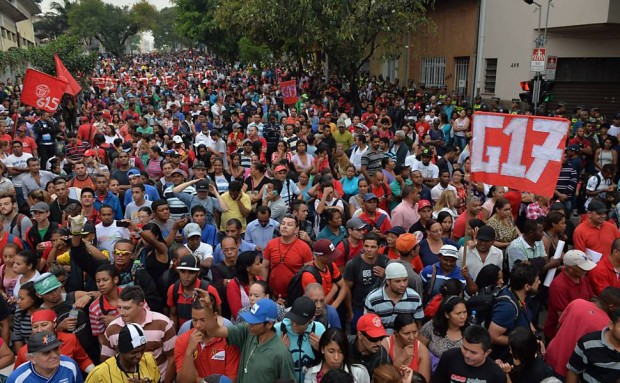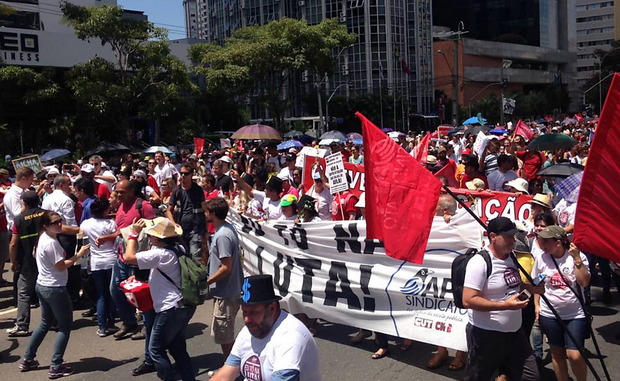
Brazilians are back on the streets protesting, denouncing water shortages, budget cuts, and price rises – but in a more politically divided nation, the mood this time round is very different.
By James Young
Brazil may never have talked as much about protests as it has over the last two years. First, there were the huge street demonstrations that spread like wildfire in June 2013. Everyone knows the story by now – a brutish response from the military police poured petrol onto anti-bus fare hike demonstrations in São Paulo, and soon it felt like the whole country (or at least the young and the middle-class portions of it) was on the streets, with thousands marching in the direction of Confederations Cup matches at the Mineirão or the Maracanã. They were complaining about, well, everything – a vague amalgam of political corruption, FIFA and the World Cup, Marco Feliciano, terrible bus services, terrible hospitals, and terrible schools. Meanwhile the world’s TV cameras, here for the football, gaped – would there be a World Cup? Was Brazil falling apart?
Yes and no were the answers to those questions – in what felt like a very Brazilian moment, not much came of the Tropical Spring at all, the mood of ferment and change dwindling listlessly into shrugs, apathy and getting on with life. Dilma Rousseff’s government hummed and hawed about political reform and promised massive investment in public transport, but there has been little sign of either. What was left of the protests turned ugly, the violence of the black blocs achieving nothing apart from driving ordinary demonstrators indoors, and the World Cup passed (generally) without a hitch – the festive atmosphere, sprightly football and heightened security presence distracting people from that silly business of political protests.
Now, it seems, protesting may be back in vogue, although recent events have little in common with the 2013 demonstrations. Last Thursday around 10,000 people took part in a Homeless Workers Movement (MTST) rally demonstrating against water rationing (pictured above), while a similar number marched in Curitiba the day before in support of striking teachers. Thousands of unhappy truck drivers have blocked highways across the country, bringing Brazil’s already shaky road network to a grinding halt. Perhaps most ominous of all, a nationwide rally calling for the impeachment of president Dilma has been scheduled for this month, with over a million people confirming their presence via social media (though the number that shows up is rarely nearly as high).
These protests, with the exception of the potential impeachment rally, are more localized and more specific in their demands than the 2013 marches. And yet Brazil’s problems remain the same, or worse, now – Marco Feliciano has been replaced by Jair “I wouldn’t rape you because you’re not worth it” Bolsonaro as the pantomime moral villain of Brazil’s capering political classes, there are water shortages in São Paulo and a gaggle of other cities (even if not all will admit it), the economy has tanked, inflation is rising, the scale of the Petrobras corruption scandal grows more mindboggling by the day, and president Dilma seems to have no idea what to do about any of it.
Why, then, did bus fare hikes get people onto the streets in their hundreds of thousands, but water rationing protests remain a more minority affair? There are some obvious reasons, such as the lack of a sparkplug moment similar to when the police shot a number of Folha de São Paulo journalists at one 2013 rally, putting public opinion firmly on the side of the protestors, or the absence now of both convenient rallying points (the Confederations Cup games) and the encouraging gaze of the international media.

But perhaps just as importantly, the mood in Brazil feels different now. For all the anger, aimed both at FIFA and Brazil’s political classes, that surrounded the 2013 protests, there was also a sense of optimism and community, as hundreds of thousands of Brazilians discovered, with some surprise, that they were all angry about the same things and if they all got together and complained about them at the same time, some good may come of it (though ultimately, it didn’t).
That shared anger and enthusiasm may have gone now, the bitterness that surrounded last year’s elections creating a polarized political environment, with the words and actions of supporters on both sides of the PT v PSDB split becoming increasingly rabid. “In 2013 it was the left that was on the streets…this year it’s going to be the right protesting, demanding impeachment of Dilma and a stop to corruption,” said Luiz Eduardo Oliveira, an anti-PT activist attacked by supporters of the party while demonstrating in Rio de Janeiro last week.
Carnaval has come and gone. As 400,000 Argentinians took to the rain-lashed streets of Buenos Aires in the so-called “March of Silence” to protest against the Kirchner government and call for justice in the case of the death of public prosecutor Alberto Nisman, Brazilians danced and frolicked in the sunshine, some wearing satirical masks of political figures. Such frivolity perhaps recalled the phrase “Brazil is not a serious country”, often attributed to Charles de Gaulle, but in fact spoken by the Brazilian diplomat Carlos Alves de Souza Filho.
And yet Brazil has long mixed its traditional themes of music and carnaval with political protest. In 1992, as the Fernando Collor government descended into an abyss of corruption, the caras pintadas (“painted faces”) took to the streets to demand his removal from office.
“In Recife, I heard a dull roar come floating up from the Avenida Conde de Boa Vista and in through the open windows of my apartment. To thrilling rapid-beaten drums, a hundred thousand young people were marching toward the centre of the city, faces painted in Brazilian green, blue and yellow. They were the painted faces and Recife’s contribution to the upsurge…an indescribable gaiety rose into the air…All around Brazil giant bald bespectacled PC (Farias, Collor’s partner in crime) dolls were being paraded down the streets, and dolls of Fernando and Rosane in convict garb. There was music and dancing and rhythmic chanted slogans,” writes Peter Robb in his book on Brazilian history and culture, A Death In Brazil.
Irrespective of whether the subject is impeachment, water shortages, or striking teachers or truck drivers, it remains to be seen whether Brazil will be able to summon the same sense of unity, and political fervour, again.

